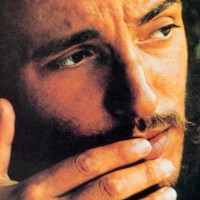As we see footage of songs such as “The Promised Land” being worked out, Bruce tells us that the themes of the new album were driven by a sense of accountability to the people he had grown up alongside. The line running through the songs expressed a commitment to life and a resilience in the face of its adversities.
You know…I hear him say these things, and I see video of him standing there shirtless, so young, rehearsing the band at his farm house in Jersey, and I think…
Later, You see him in a restaurant booth, flipping the jukebox entry to Born To Run. It’s all in good fun but then you realize the enormous pressure that has been put on him from all sides: the successful album and tour, making the covers of Time and Newsweek and getting stuck in a lawsuit with former manager Mike Appel over the control of his music, over the control of his life. What was I doing at that same time? Whatever it was, it surely didn’t involve this level of coherency and single-mindedness of purpose.
While most of the fan base knows the stories involved — of the oppressive schedule, of the endless stream of songs, of the arguments over what material makes the cut — it is mesmerizing to see behind that curtain and to see these men struggle through. They often look quite haggard, but they’re there for each other. That might sound like a cliché but the end result can’t be denied. It’s also fun to see the band breaking the tension with hijinx like placing bets over the final length of the song they’re working on. Bruce might have been the taskmaster but the guys knew how to make light of his obsessions.
Throughout the film, Springsteen returns to the thoughts that shaped the album: the necessary bareness and austerity, the “apocalyptic grandeur,” the idea of dealing with unavoidable limitations while pressing on to lead the life you want, the struggle to balance necessary compromises without going so far as to lose yourself, the desire to honor parents, community, and the lives of those who grew up with you. In the context of “Factory,” Bruce relates the paradox of his dad’s place of work, a factory that both gave him life and also took a lot away…his hearing.
After Darkness‘s release, we see some footage of the band exploding on the subsequent tour. Here, Springsteen brings up the magic of what happens at a show, when the band and the audience come together to pull something out of the air that didn’t even exist a few minutes earlier. I’ve experienced such moments and that feeling is overwhelming. It’s the kind of power that raises the music up far beyond mere entertainment.
The documentary ends with before/after shots of each band member, first as young men, then back to the present. Yes, there are a lot of wrinkles on those faces, but they’re easy to forget as the credits roll and they replay “Darkness On The Edge Of Town” from the Paramount set. They may be older, richer, and more famous, but it’s clear that this music still means as much to them as it does to the rest of us.
- How Eric Clapton’s ‘Me and Mr. Johnson’ Made the Case for British Blues - March 20, 2024
- Why Todd Rundgren’s ‘Back to the Bars’ Remains So Powerful - December 13, 2023
- Reevaluating Bruce Springsteen’s ‘The Wild, the Innocent and the E Street Shuffle’ - September 11, 2023




